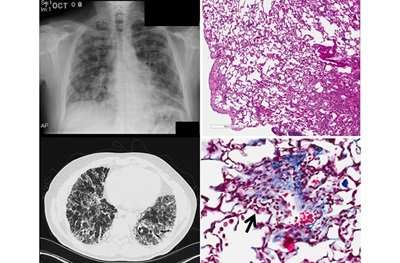First mouse model to mimic lung disease could speed discovery of more effective treatments

The biggest hurdle to finding effective therapies for idiopathic pulmonary fibrosis (IPF) – a life-threatening condition in which the lungs become scarred and breathing is increasingly difficult – has been the inability to fully model the disease in animals, limiting the ability to observe and understand the disease. Now, a team of researchers from Penn Medicine has developed the first mouse model with an IPF-associated mutation, which induces scarring and other damage similar to what is observed in humans suffering from the condition. The findings are published this week in the Journal of Clinical Investigation.
"No one has been able to make a model to date that actually mirrors what's going on in humans," said senior author Michael F. Beers, MD, a professor of Pulmonary, Allergy, and Critical Care in the Perelman School of Medicine at the University of Pennsylvania, and research director of the Penn Interstitial Lung Disease Center. "Now, we have a model that resembles the pathology, physiology, and molecular signs found in patients, which will allow us to work out new pathways and targets, and test drugs in more clinically relevant ways."
IPF, often caught in the mid to later stages, is diagnosed in about 50,000 people a year in the United States, and kills nearly 40,000 people during that same time. While there is no cure, two U.S. Food and Drug Administration-(FDA) approved drugs are used to slow the disease's progression, and some patients receive lung transplants. The median survival rate is two to three years from the time of diagnosis.
Current IPF mouse models rely on a chemotherapy drug to induce an "inflammatory storm" in the lungs that creates lesions about 21 days later, Beers said. But that doesn't reflect the process that actually occurs when humans develop the disease.
In the new mouse model, the team altered a gene for making a protein called surfactant protein-C (SFTPC), which is essential for lung function. Mutations in the SFTPC gene, which are found in certain human lung cells called alveolar epithelial cells (AECs), are a promising lead for homing in on one cause of the disease.
Knowing the importance of these lung AECs in the development of the disease, the team induced the SFTPC mutation into the AECs of normal mice to elicit a response. Within three days of inducing mutant SFTPC expression in adult mice, lung tissue was infiltrated by inflammatory cells; this was followed by an abnormal accumulation of inflammatory cells within tiny air sacs in the lungs. Rapid death was also observed in 30 to 50 percent of the animals. Similar to what has been observed in patients, the surviving mice went on to develop progressive fibrosis and loss of lung function.
Using the new animal model, the researchers will next look at pathways that lead to the initiation and persistence of lung fibrosis. "Now the questions become, why are those epithelial cells attracting both inflammatory cells and fibrotic cells? And how do these different cells talk to each other?" Beers said.
"We're also taking a big data approach by profiling the genetic, proteomic, and inflammatory changes in the mice over different time points," Beers added. "You can't do that in humans because we see these patients once their disease has already progressed. We know very little about what happens in the beginning. This model will help answer some of those questions and hopefully lead to more effective therapeutic drugs to slow the disease."
More information: Timothy S. Blackwell. Lung injury and fibrosis induced by a mutant form of surfactant protein C, Journal of Clinical Investigation (2018). DOI: 10.1172/JCI122727


















